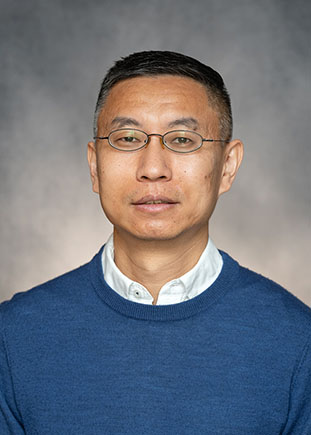Fangwei Si
Cooper-Siegel Assistant Professor of Physics
Wean Hall 6311
Biological Physics Experiment

Education & Professional Experience
Cooper-Siegel Assistant Professor of Physics, Carnegie Mellon University, 2024-
Assistant Professor of Physics, Carnegie Mellon University, 2022–
Postdoctoral Researcher, Department of Integrative Structural and Computational Biology, The Scripps Research Institute, 2020–2022
Postdoctoral Researcher, Department of Physics and Section of Molecular Biology, University of California, San Diego, 2015–2022
Research Interests
Our drive is to discover “biological laws” that can help us understand living systems in a quantitatively precise way. Towards this goal, we develop/adapt tools, do rigorous measurements, and define new concepts. We are currently searching for simple yet fundamental rules connecting the complicated form of bacterial cells and their fitness in different environments, specifically focusing on cell surfaces and bacteria-phage interactions.
Physiological and biophysical principles of cell surfaces: The cell membrane can be seen as a microscopic version of Manhattan, NYC. The cell almost packs the limited membrane space with proteins that provide essential functions. With such high packing density, the cell must evolve to do really good job in “floorplanning” its membrane to optimize the fitness. The quantity and spatial organization of membrane proteins are crucial in determining growth rate, death rate, as well as adaptability in new environments. We are quantifying basic membrane properties using single-cell microfluidics and imaging approaches and performing perturbation experiments to test quantitative models.
Quantitative principles of cellular adaptation: The abundance of many cellular components is often more than a cell needs. For example, a bacterial cell always has extra copies of essential
molecular machines, e.g., ribosomes, or extra physical space, e.g., membrane area – removing some of them does not affect corresponding cellular functions. Why does the cell use such a seemingly wasteful strategy? It is thought that extra components are essential for the cell to adapt to a new environment, and cellular adaptation remains an unresolved fundamental biological problem. We will experimentally gauge how the extra abundance of cellular components is tuned in different environments, hopefully to gain insights into the biological mechanisms underlying cellular adaptation.
Physiological and biophysical principles of bacteria-phage interactions: While bacteriophages (viruses that infect bacteria) are often known for killing their host, a large class of bacteriophage are very temperate – they live quite peacefully with their bacterial host, and do not kill when replicating and leaving the host. It is even reported that many phages help their host survive environmental challenges. However, the fitness benefit and cost of phage production in bacterial hosts is poorly understood. We are trying to delineate the physiological consequences (e.g. growth, survival and adaptability to new environments) of the bacterial-phage interactions. This is also a great opportunity to bridge the quantitative principles of microbial growth at both single-cell and community levels.
Selected Publications
Fangwei Si et al., Mechanistic Origin of Cell-Size Control and Homeostasis in Bacteria, Current Biology 29(11), 1760-1770.e7 (2019)
S. Jun, F. Si, R. Pugatch, & M. Scott, Fundamental principles in bacterial physiology—history, recent progress, and the future with focus on cell size control: a review, Rep. Prog. Phys. 81 056601 (2018)
Fangwei Si et al., Invariance of initiation mass and predictability of cell size in Escherichia coli, Current Biology 27(9), 1278-1287 (2017)
F. Si, B. Li, W. Margolin, & S.X. Sun, Bacterial growth and form under mechanical compression, Sci. Rep. 5, 11367 (2015)
Dong-Hwee Kim et al., Volume regulation and shape bifurcation in the cell nucleus, J. Cell Sci. 128 (18): 3375–3385 (2013)
F. Si, K. Busiek, W. Margolin, & S.X. Sun, Organization of FtsZ filaments in the bacterial division ring measured from polarized fluorescence microscopy, Biophys. J. 105(9) 1976-1986 (2013)
H. Jiang, F. Si, W. Margolin, & S.X. Sun, Mechanical control of bacterial cell shape, Biophys. J. 101(2), 327-335 (2011)
More Publications:
Google Scholar